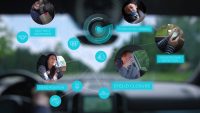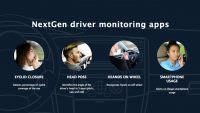Israeli Firm Debuts One-Camera Vehicle Surveillance System
January 17, 2019
At CES 2019, Tel Aviv-based Guardian Optical Technologies debuted Optical Cabin Control (OCC) for the car’s interior. The single camera, a bit bigger than one featured in a mobile phone, is installed in the car’s ceiling and uses machine learning to keep an eye on the driver — and the kids in the backseat. More specifically, the camera watches to see if the driver takes his hands off the wheel, his eyes off the road or closes his eyes. To train the system, the company hired a diverse group of people, wearing different clothes and holding various accessories and pets.
Wired reports that this Israeli company is going up against the systems used in such “semi-autonomous tools like Tesla Autopilot and Cadillac Supercruise,” which “require the driver pay attention even when the car’s doing the work.”

Audi has a gaze tracking system, Cadillac has an infrared camera watching head position, and Tesla and Nissan use “a torque sensor to register when the human’s hands are on the steering wheel.” Guardian said it matches those system’s capabilities and then some, by offering a wider field of view.
The system also watches the kids in the backseat, significant since the National Safety Council reports that “an average of 37 children die of heatstroke in cars in the U.S. every year; about half of them forgotten by their parents or caregivers.” Chief executive Gil Dotan said his system can also “detect whether the passenger seat is occupied or empty, to activate the airbag or not … [and] verify whether everyone has buckled their seatbelt,” as well as “look for behaviors that indicate distracted driving.”
Dotan’s sales pitch to auto manufacturers is that the Guardian system can replace “today’s hodge-podge sensor suite,” and save “up to $370 per car.” “The cost per feature is lower, and that means they can sell more cars with higher margins,” he said.

But some industry experts are skeptical. Now-retired Delphi chief technology officer Jeff Owens said that, “the pressure sensors that now detect human butts in seats are inexpensive and trustworthy.” Then there’s the fact that the National Highway Traffic Safety Administration would have to sign off on the changes, and “they’re not exactly quick to change their standards.”
By replacing multiple sensors with one, automakers would have to coordinate multiple engineering groups, which leads Owens to say that, “replacing all those sensors is a pretty far-fetched dream.” Last, there’s the issue of whether drivers will accept having a camera in their cars; although cameras are becoming more common, “automakers might be enticed by the chance to sell data around their drivers’ habits and behaviors.”

No Comments Yet
You can be the first to comment!
Sorry, comments for this entry are closed at this time.